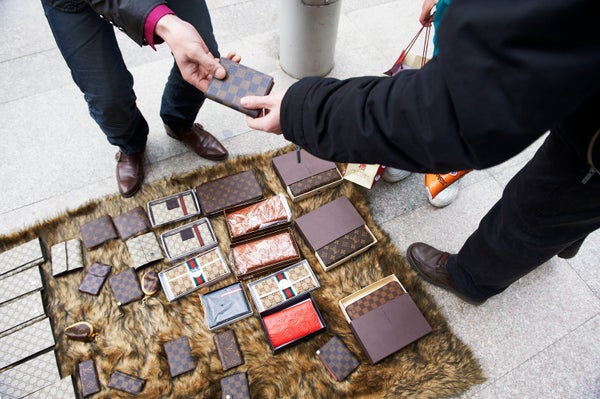This article was published in Scientific American’s former blog network and reflects the views of the author, not necessarily those of Scientific American
As a culture, we place a high premium on authenticity, but how do we actually judge what’s authentic from what’s not? The simple answer is that we rely mostly on labels. Walk into any store and you’ll find a veritable galaxy of product labels certifying everything from free-range salmon to conflict-free diamonds. We tend to take these at face value, perhaps because it’s more comforting to imagine counterfeiting as a distant problem of some bygone era. But the truth is, the counterfeiting business has never been better.
Fake goods account for a staggering 3.3 percent of global trade. While footwear and clothing comprise a large chunk of that, counterfeiters are increasingly turning their attention to more sinister grifts, trafficking in phony medical equipment, pharmaceuticals and foodstuffs. In February, the WHO issued an alert warning patients and physicians of a fake cancer drug being circulated in the U.S. and Europe. According to advocacy group Oceana, some 25 percent of the world’s seafood is mislabeled. By some estimates, as much as 80 percent of Italian olive oil is fake. And that’s only scratching the surface.
But what if there were a better way to guarantee the integrity of our consumer goods than a simple label that’s ultimately even easier to forge than the product? Researchers have already begun looking to wavelength data and the analysis of microscopic features intrinsic to substances as a potential solution to the counterfeiting epidemic.
On supporting science journalism
If you're enjoying this article, consider supporting our award-winning journalism by subscribing. By purchasing a subscription you are helping to ensure the future of impactful stories about the discoveries and ideas shaping our world today.
Unlike a product label, these microscopic features and wavelength signatures are unique, inalterable and can be observed in just about any substance in the universe, with the exception of black holes. In analyzing this unique signature, the observer is looking at the very molecular essence of a thing. It’s authenticity, then, is assured not by some regulatory body, but by nature itself.
Take diamonds as just one example. From RFID tags to laser etchings, the gem industry uses a range of methods to track physical diamonds and ensure that characteristics like carat and clarity match up against certified records. But RFID tags can be removed, and laser etchings can be re-lasered. What can’t be tampered with are the diamond’s microscopic features. That’s what we’re scanning for.
Of course, this type of analysis isn’t a novel concept. What is new, however, is the advent of miniaturized scanner technology small enough to clip onto a smartphone, paired with artificial intelligence models capable of authenticating materials in the real world.
One solution currently being evaluated uses a mobile optic analyzer capable of capturing features at a one-micron resolution. To put that into perspective, a single inch contains 25,400 microns. A strand of human hair is about 82 microns wide. At a single micron, bacteria become visible. This sensor is aided by specialized AI models trained to help identify unique microscopic features. The mobile optic analyzer also captures wavelength data. Both wavelength and microscopic data are then evaluated using AI models. Finally, the results are stored on a blockchain network, where properties such as immutability ensure that they can’t be tampered with.
To be clear, this isn’t just about luxury goods like diamonds and fancy olive oils. We’re exploring Mobile optical analysis to validate cancer drugs, construction metals, diesel fuels, electronic computer chips and animal feed. Nor is this innovation limited in scope to the Western world. Indeed, with as much as 70 percent of drugs in Africa being counterfeit, the technology’s greatest impact may well be in the developing world.
One day very soon, optical analyzers could be a standard smartphone feature, as ubiquitous in mobile devices as cameras. Though it’s never easy to predict how quickly new technology will be adopted, one thing is already certain: The tools needed to combat the growing counterfeiting epidemic already exist. Now, it’s time to use them.
